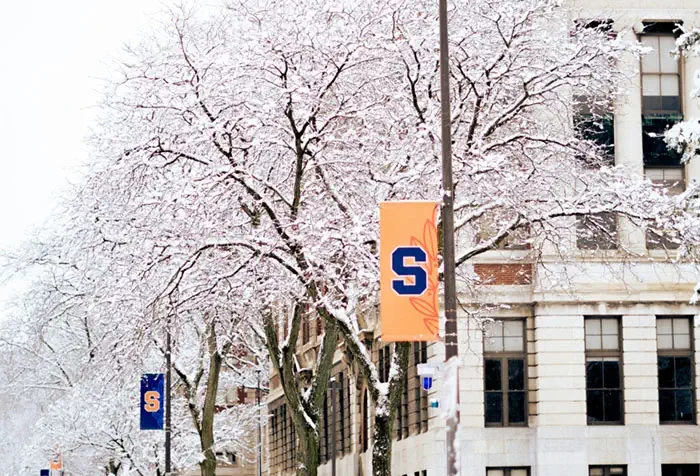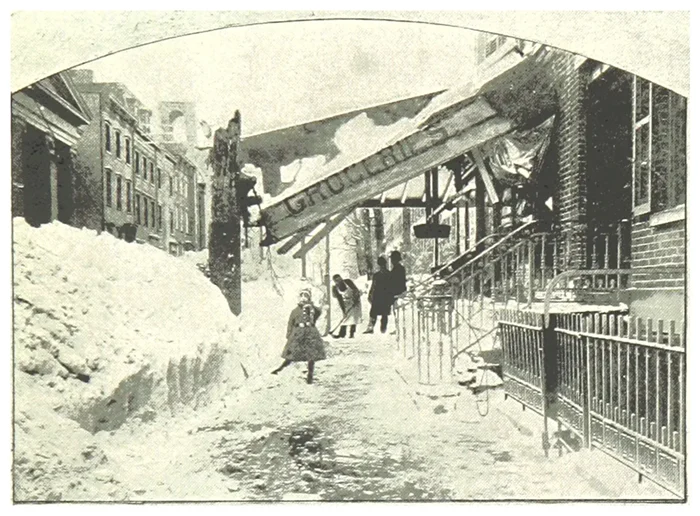Syracuse, New York, has built its reputation on snow — and lots of it. Perched in the heart of Central New York, this small but mighty city regularly tops lists of the snowiest places in the United States. Its winters are both legendary and defining, shaping everything from its infrastructure to its sense of community.
Here are five key things to know about why Syracuse winters are unlike anywhere else.
1. Syracuse Is America’s Snowiest Major City
Each winter, Syracuse earns its reputation as one of the snowiest cities in the United States. The city averages 127.8 inches of snowfall per year; that’s more than ten feet of snow in a typical season. Some years have even exceeded 150 inches, depending on the intensity of lake-effect snow events from nearby Lake Ontario.
1993 was a record-breaking year for Syracuse. In that single calendar year Syracuse received a whopping 192.1 inches. This was also the year that Syracuse was hit by the Blizzard of 1993, better known as the Storm of the Century. 42.9 inches of snow fell on the city in under 48 hours.

To celebrate this frosty dominance, Upstate New York cities compete each year for the Golden Snowball Award, a friendly rivalry that tracks seasonal snowfall totals among Syracuse, Rochester, Buffalo, Binghamton, and Albany. Syracuse has claimed the top spot more times than any of its competitors, cementing its title as the Snow Capital of the East. The city even outpaces Anchorage, Alaska, and Buffalo in total annual snowfall.
This near-constant blanket of snow shapes both daily life and city planning. Everything from road maintenance and public transit schedules to winter festivals and community identity revolves around the rhythm of the snow season. For residents, heavy snow , it’s an expected, almost welcome part of the year that defines life in Central New York.
2. Lake-Effect Snow Is the Secret Ingredient
Lake-effect snow is a hallmark of winter across the Great Lakes region, especially in places like Syracuse, Buffalo, and Erie. It occurs when cold, dry air, often originating from the Canadian Arctic, moves across the open, relatively warm waters of the Great Lakes. As this air travels over the lake surface, it picks up both heat and moisture, which are transferred into the lowest layers of the atmosphere.
The warmer, moisture-laden air then begins to rise through the colder air above, causing condensation and the formation of towering cumulus clouds. These clouds align with the prevailing wind direction, creating long, narrow snow bands that can produce extraordinary snowfall rates (often 2-3in per hour or more).
One of the most remarkable features of lake-effect snow is its intense local variation. Because the snow bands are narrow and highly sensitive to wind direction, conditions can change dramatically over very short distances. In one neighborhood, blinding snow may be falling, while just a few miles away, the sky can be clear and sunny.
Wind direction and fetch (the distance air travels across open water) play crucial roles in determining where these snow bands form and how severe they become. When winds blow consistently from the northwest, for example, areas southeast of Lake Ontario (such as Syracuse and Oswego) can see heavy accumulation. When winds shift, the snow belts move with them.
Topography also influences snowfall patterns. Hills and ridges near the lakes help lift moist air, enhancing snowfall totals in downwind areas. Meteorologists at the National Weather Service carefully monitor all these variables (windspeed, temperature contrast, etc.) when forecasting lake-effect snow events.
The result is one of the most awe-inspiring natural weather phenomena in North America: highly localized, fast-developing snowstorms capable of transforming a landscape in a matter of hours.
When very cold air passes over the relatively warmer, unfrozen waters of the Great Lakes, narrow snow bands can form and dump intense, localized snowfall downwind, including across Central New York.
Residents are used to “micro-winter zones”. One neighborhood may be clear, while another just a few miles away is buried under three feet.
3. Snow Is a Way of Life
Snow is a part of Syracuse’s personality and culture. Residents live, work, play, and even celebrate around snowfall. The city operates one of the most efficient snow management systems in the country, with 24/7 plow crews, pre-treatment brining, and an extensive network of salt and sand operations. Snow removal is so effective that major roads are often clear within hours of a storm, and city services rarely shut down. Businesses stay open, students head to class, and life continues almost uninterruptedeven during blizzards that would paralyze other regions.
Locals wear their endurance as a badge of honor; surviving a Syracuse winter is almost a rite of passage.
The community also finds ways to turn all that snow into celebration. Syracuse Winterfest, held each year in Februrary, transforms downtown into a winter carnival with ice sculptures, outdoor dining, live music, and hot-chocolate crawls. Neighborhoods host sledding events, snowshoe races, and cold-weather markets. Even Syracuse University embraces the season, organizing snow games and campus traditions that make the most of the long winters.
Syracuse University leans into the cold with winter events with snowgames, events, and has even had giant inflatable snowglobes for the kids to enjoy.

4. Syracuse Turns Cold Into Innovation
Decades of extreme winters have made Syracuse a hub for cold-climate innovation. The Syracuse Center of Excellence in Environmental and Energy Systems (SyracuseCoE) studies how buildings perform in cold weather, developing greener heating systems, improved insulation, and renewable energy designs tailored for snowy cities.
The region’s universities ( like Syracuse University and SUNY College of Environmental Science and Forestry (ESF)) also use the cold as a living laboratory. Students and researchers analyze how snow, temperature, and air quality affect both urban infrastructure and public health.
Even the city’s planning departments draw innovation from its winters. In recent years Syracuse has implemented a real-time Snow Operations Map that tracks plow locations, street clearing status and impediments such as parked cars, using a combination of fleet sensors, GIS dashboards and cloud-based routing tools. The system boosts transparency by showing residents in near real time which roads have been plowed and when, helping the city optimize operations, respond faster, and maintain mobility during heavy snow events.
5. Climate Change Impacts the SnowBelt
Even in the snow capital, winters are changing. In 2023 the average temperature was nearly 4 degrees warmer than usual. This can result in more ice and rain then snow, increasing hazardous road and infrastructure conditions during the colder months.
Other risks of warmer winters include the risks of flooding, damage to personal property from eweather events, and changes to natural ecosystems.
The Takeaway
Syracuse winters are a testament to resilience, innovation, and a little festive fun. From record-breaking snowfalls to cutting-edge climate research, the city shows that embracing winter can lead to innovation, community strength, and even pride.
If you’re looking for the true heart of an American winter, you’ll find it in Syracuse (under a blanket of snow).
Image Sources
- Image: 1992 Toyota Tercel partially dug out after the Superstorm of 1993. Source: Wikimedia by Thelmadatter. CC BY-SA 3.0
- Featured Image: Syracuse University Campus on a snowy day, by Jess Van


